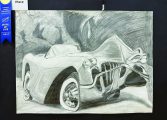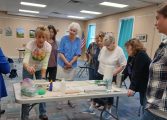At Maggie’s House, it was Susan and Ronald Salomon who were exhibiting their line of exquisitely made scarves, hats and hand knitted baby sweaters and hats. The display rack was filled with hand woven hats and scarves in every imaginable color. Some of the hats had contrasting brims, trims or buttons for embellishment. The scarves were made of rayon, chenille and bamboo and all buttery soft.
“I like the feel around the neck,” said Ronald. “Bamboo is a fad among weavers and it takes twice as long to weave something than chenille.” When asked about dying or spinning his yarns, he stated, “If I dyed my yarns then I wouldn’t have time for anything else including weaving and the same with spinning my own yarns. I used to but it is too time consuming and I would have charge far more for a piece than I do now.” Paul admits he loves all colors and that is evident in his selection of scarves and hats from eggplant to aqua, gold and turquoise.
Susan’s knitting is flawless and sweet but she uses thicker yarns in her work to make the sweaters more durable.
Across the street was an exhibit by artists Rob Browning and John Hughes. Both are accomplished artists with impressive qualifications.
Browning’s work is out of the ordinary and he has a knack of drawing the onlooker in with offbeat subjects, including a stilt walker outdoors with a landscape as his surroundings. A man and his dog look at a wall while in another painting, a woman’s face is obscured by shadows from a nearby window blind. Like most artists, his models are pensive or brooding but this lends to the drama of these surrealistic subjects. Similar to the style of Edward Hopper, Browning uses bold color and strong clean lines in his work. The charm in Browning’s work lies within his eerie unconventional images.
On the opposite side of the spectrum is John Hughes, whose experimentation with style is evident in his work, and seem to appeal to a wide range of onlookers, everything from Renaissance altar pieces with an avant-garde twist to whimsical roosters. He makes stunning statement with his water paintings, which are studies in light, texture and patterns.
Hughes began painting at age ten, growing up around the coastal wetlands and Pine Barrens of New Jersey.
“My current work is focused on the Virginia landscape and reminiscent of the beauty and the mystery of these often remote areas I enjoyed as a boy,” said Hughes. By using a series of photographs taken in chosen locations and under a variety of lighting conditions, Hughes said, “I hoped to capture the more improbable patterns and shapes found in nature in order to express a sense of the sublime.”
“I am drawn to places where textures seem to collide and abstract forms emerge,” he said. “The viewer in my paintings, often find themselves standing between the developed and undeveloped world suspended between the familiar and the unseen.” He sums it up best in describing his work as a hybrid between traditional painting and the often unexpected accuracy of a photograph.
A trip to Jan Crowther’s studio, Frog Moon Pottery, yields a different perspective. Her pottery style is uniquely her own, using Japanese motifs and styling as an inspiration for her work. Her individual style features strong lines and draws on a variety of things in her environment for inspiration. She goes beyond the conventional look of pottery, creating one-of-kind pieces not seen anywhere else.
Crowther and her husband Paul, create both wheel-thrown and hand built stoneware pieces. Crowther admits she loves the process of creating in clay and adding the fine details to her unique pieces.
Looking at Father Mefodii’s work is like going back in time and marveling at the ancient works from master painters and iconographers of the 13th and 14th. century. Father Mefodii, a monk from the Skete of St. Maximos the Confessor, is a master iconographer at the Prosopon School, explained that there are 21 steps to completion of a piece. He discussed in detail how some of the steps are accomplished.
Fluvanna Art Association member Peg Redd, always has a variety of work for viewing. Though Redd’s subjects are simple, she always gives deeper meaning to simple subjects and objects, everything from a chair in a variety of positions to a graphite of a bathroom. Influenced by masters like Chagall and Matisse, Redd treats uncomplicated objects and people in an unconventional way revealing her own extraordinary style in her compositions. There is always originality in her work and this is seen with some of her current work in landscapes. Redd goes beyond the known to what is unknown. One of her landscapes features bright bold colors, red for grass, yellow, blue and green for trees, and turquoise blue lines for rippling water. It’s a daring abstract concept and remains Redd’s signature work.
Walking into Lyndsay Nolting’s home one is struck by her enormous oil paintings, daring brush strokes and soft, muted colors and ethereal, impressionistic style Nolting’s work lends a modern flavor to the rusticity of her environment. Nolting loves her solitary life and that feeling is reflected in her paintings of woods and landscapes.
Last on the tour, depending on what direction you are going or coming, was Tom Tartaglino. Tom Tartaglino’s studio was lined with a variety of miscellaneous oil paintings from a man sitting around a campfire, to a large circular painting of a tree with bare limbs to traffic to landscapes and assortment of people in a of different and unique poses and environments. Tartaglino has paintings hidden in every nook and cranny of his studio and like hidden treasures, onlookers marveled at his unlimited imagination in each original piece. Realistic in his style, Tartaglino is also a master of composition, seeing different angles and possibilities within his subject.




